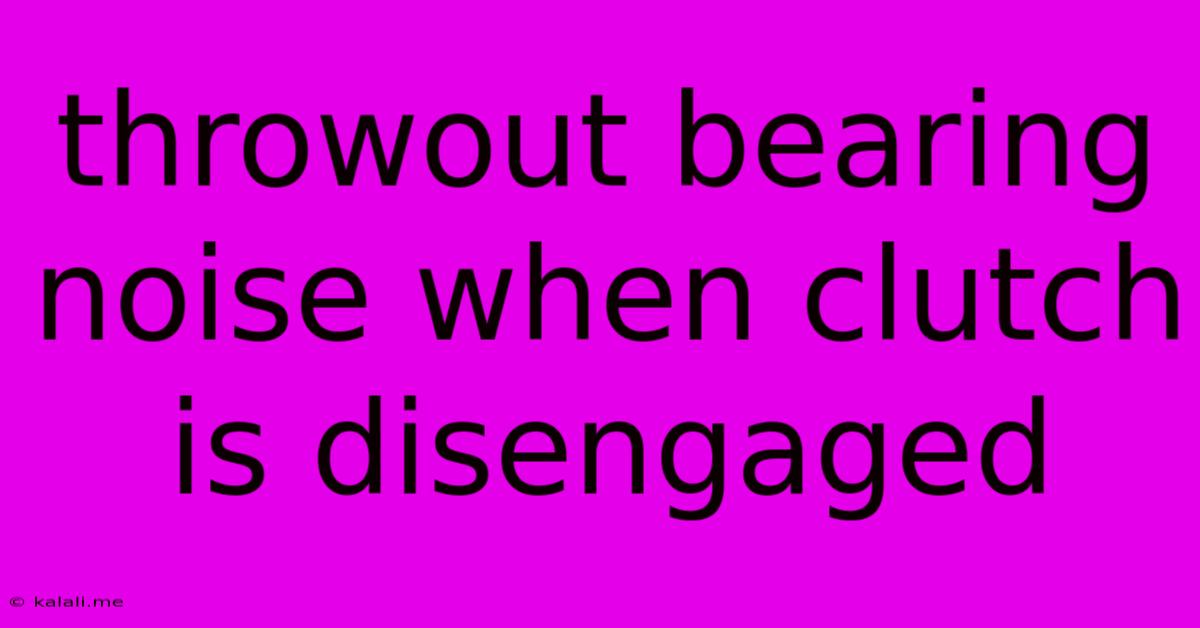Throwout Bearing Noise When Clutch Is Disengaged
Kalali
Jun 02, 2025 · 3 min read

Table of Contents
Throwout Bearing Noise When Clutch Is Disengaged: Diagnosis and Solutions
Meta Description: Experiencing a noise from your throwout bearing when the clutch is disengaged? This article provides a comprehensive guide to diagnosing the problem and exploring potential solutions, helping you understand the cause and address the issue effectively.
Are you hearing a grinding, squealing, or rattling noise coming from your car's clutch when you disengage the pedal? This is a common issue, often pointing towards a problem with your throwout bearing. This crucial component plays a vital role in disengaging the clutch, and its failure can lead to significant driving issues. Understanding the cause of the noise and identifying the problem early is key to preventing further damage and costly repairs. This guide will help you navigate the diagnosis and potential solutions.
Understanding the Throwout Bearing and its Function
The throwout bearing acts as an intermediary between the clutch pedal and the clutch itself. When you depress the clutch pedal, the throwout bearing engages the pressure plate, disengaging the engine from the transmission. This allows you to shift gears smoothly. A faulty throwout bearing will often manifest as noise – specifically when the clutch is disengaged (pedal pressed).
Common Throwout Bearing Noise Symptoms
Several sounds indicate potential throwout bearing problems. These include:
- Grinding Noise: A harsh, metallic grinding sound is a classic symptom of a failing throwout bearing. This usually occurs when the bearing is damaged or worn, causing metal-on-metal contact.
- Squealing Noise: A high-pitched squeal is often associated with a dry or lubricated throwout bearing. Lack of lubrication causes friction and leads to this characteristic sound.
- Rattling Noise: A rattling or clicking noise can suggest that the bearing is loose or damaged internally, causing components within the bearing to rattle against each other.
Diagnosing the Problem: Is it Really the Throwout Bearing?
While the noises mentioned above strongly suggest a throwout bearing issue, it's crucial to rule out other potential causes. These include:
- Transmission Issues: Problems within the transmission itself can sometimes mimic throwout bearing noise.
- Clutch Disc Problems: A worn or damaged clutch disc can also produce noise, particularly when the clutch is engaged.
- Pilot Bearing Issues: The pilot bearing, located on the input shaft of the transmission, can also create similar noises.
To isolate the problem, listen carefully to the location and nature of the sound. If the noise is clearly emanating from the clutch area and only occurs when the clutch pedal is depressed, the throwout bearing is a strong suspect. A mechanic can help confirm the diagnosis through a thorough inspection.
Solutions: Repairing or Replacing the Throwout Bearing
If the throwout bearing is indeed the culprit, you'll likely need to replace it. This is a job best left to a qualified mechanic, as it involves removing the transmission. Attempting this repair yourself without proper experience and tools can lead to further damage and increased repair costs.
While a complete clutch replacement might be suggested, especially if other clutch components are nearing the end of their life, often only the throwout bearing replacement is necessary. The cost of this repair varies greatly depending on your vehicle's make and model, as well as labor costs in your area.
Preventive Maintenance: Extending Throwout Bearing Lifespan
While throwout bearing failure isn't always preventable, taking care of your vehicle can prolong its life. Regular clutch maintenance, including careful driving habits (avoiding harsh starts and stops), can significantly reduce the wear and tear on the bearing and other clutch components.
This includes avoiding riding the clutch – keeping your foot off the pedal unless shifting gears. Additionally, ensuring your vehicle receives regular servicing, including inspections of the clutch system, can help catch potential problems before they become major repairs.
Understanding the signs and causes of a failing throwout bearing can help you address the problem effectively and prevent further damage to your vehicle. Remember to consult a qualified mechanic for diagnosis and repair to ensure a safe and efficient outcome.
Latest Posts
Latest Posts
-
How Many Black Cards Are In A Deck Of Cards
Jun 04, 2025
-
Cost Of Living By Zip Code Data
Jun 04, 2025
-
How To Turn Off Phone Calls On Iphone
Jun 04, 2025
-
How To See Imessages On Icloud
Jun 04, 2025
-
D3100 How To Get Continuous Recording Focus
Jun 04, 2025
Related Post
Thank you for visiting our website which covers about Throwout Bearing Noise When Clutch Is Disengaged . We hope the information provided has been useful to you. Feel free to contact us if you have any questions or need further assistance. See you next time and don't miss to bookmark.